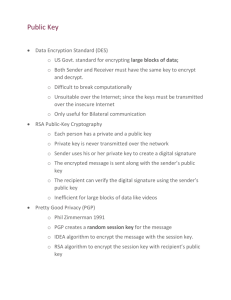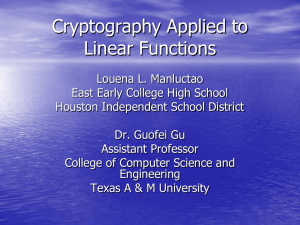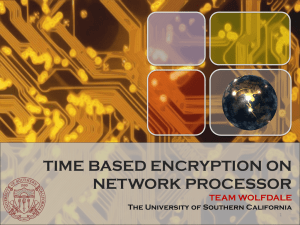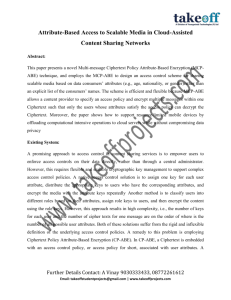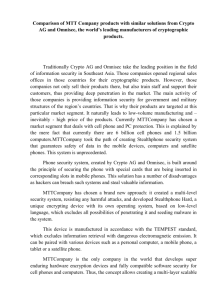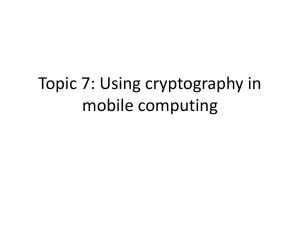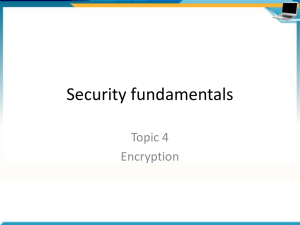Slides for Lec 1 - Computer Science and Engineering
advertisement
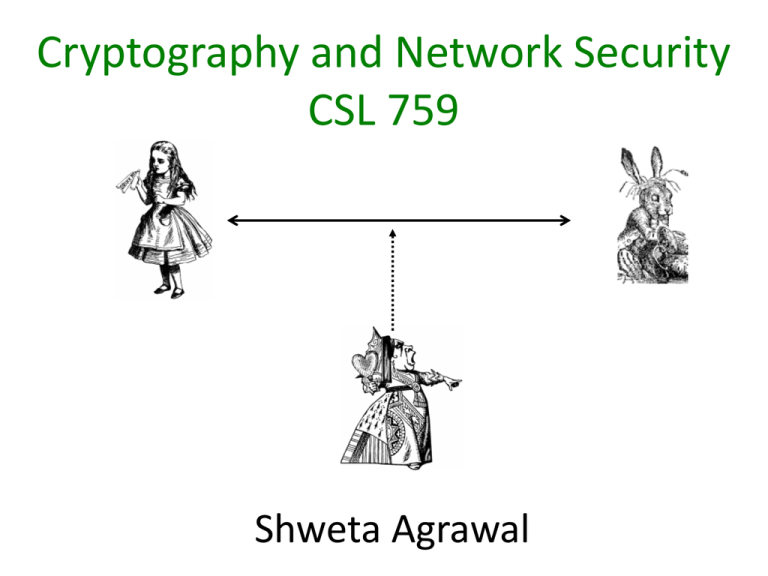
Cryptography and Network Security CSL 759 Shweta Agrawal Course Information • • • • • • 4-5 homeworks (20% total) 2 minors (15% each) A major (30%) A project (20%) Attendance required as per institute policy Scribe / Challenge questions (Extra Credit) When : Tu-Wed-Fri 6 to 7 pm Where : Bharti, room 201 Course Webpage : http://www.cse.iitd.ac.in/~shweta/teach.html Administrative stuff Teaching Assistants: – Chandrika Bharadwaj chandrika.bhardwaj@gmail.com – Abhay Gupta abhay3390@gmail.com – Nikhil Kumar nikhilkumar4@gmail.com – Utkarsh Ohm utkarshohm@gmail.com Office Hours : TBA Policies etc… • Ask questions! • Make the class interactive. We’re all here to learn. • Switch of cellphones, laptops, anything distracting. • Highest ethical standards expected. Any dishonesty/cheating of any kind will result in failing the course. Course Reading • Will not follow any one book. But KatzKindell’s “Introduction to Modern Cryptography” will be handy. • Bellare-Goldwasser’s lecture notes – http://cseweb.ucsd.edu/~mihir/papers/gb.pdf • Lecture notes by Yevgeniy Dodis (http://www.cs.nyu.edu/courses/spring12/CSCIGA.3210-001/index.html ) and Luca Trevisan (http://theory.stanford.edu/~trevisan/cs276/ ) What is this course about • Theoretical foundations of cryptography • Mathematical modeling of real world attack scenarios • Reductions between crypto primitives and hard number theoretic problems • Using cryptographic building blocks to build more complex real world protocols What this course is NOT about • Implementing secure systems • Real world attacks / hacking • Analyzing hardness of underlying number theoretic problems such as factoring etc You can do your projects on these topics if you like! Course Outline • Foundations : Principles of crypto design, number theory, OWF, OWP, TDP, PRGs, PRFs, MACs • Constructions : symmetric and public key crypto, digital signatures, MPC • Advanced Topics: Zero Knowledge, Functional encryption, fully homomorphic encryption, broadcast encryption etc Cryptography • A mathematical science of controlling access to information • Cryptography deals with methods for protecting the privacy and integrity while preserving functionality of computer and communication systems. What would we like to achieve? Real World Problems #1 : Secure Elections Multi-party computation! VOTES VOTE COUNTING Winner ? CORRECT : Winner determined correctly SECURITY : individual vote privacy maintained #2 : Protecting your code I know a better algorithm to factor numbers! Program Obfuscation! code O B F U S C A T O R Obfuscated code • Produces correct output • Impossible to reverse engineer #3 : Activism with safety Probabilistic algorithm C = Encrypt (“The election was rigged”, R) R, R’ : Random bits Under coercion, reveal R’ s.t. C =(“Really like to cook”, R’) Deniable Encryption! #4: Computing on encrypted data Users access data and infrastructure on-the-go Cloud stores data about you, me and many more I should learn information about myself but no information about you #5: Traitor Tracing I’ll buy one license And use it to forge and sell new licenses … Can we catch him ? 15 #5: Traitor Tracing • N users in system, One PK, N SKs • Anyone can encrypt, only legitimate user should decrypt • If collusion of traitors create new secret key SK*, can trace at least one guilty traitor. 16 This course …. 1. How can we build these things from math ? 2. What guarantees can we have ? 3. How do we move from messy real world scenarios to clean mathematical definitions? 4. How do theorems in math say anything about real world attacks? Building Blocks St. Pancreas International Station - 18 months, 150,000 LEGO bricks Warren Elsemore What he started with Building cryptography • Same idea! One way functions, trapdoor permutations, Pseudo random generators, PRFs Symmetric key crypto, public key crypto, Digital signatures …… Multiparty computation, homomorphic encryption, functional encryption, deniable signatures, obfuscation, traitor tracing ….. Principles of Crypto Design [Katz-Lindell] 1. Formulate a rigorous and precise definition of security for cryptosystem – security model. 2. Precisely formulate the mathematical assumption (e.g. factoring) on which the security of the cryptosystem relies. 3. Construct cryptosystem (algorithms) and provide proof (reduction) that cryptosystem satisfying security model in (1) is as hard to break as mathematical assumption in (2). 1: Security Model Real world attacks Crypto Proofs Security Model : Mathematical definition that scheme has to satisfy Scheme achieves security in given model = Scheme secure against attacks captured by that model Case Study : Secure encryption Every pair of users must share a unique secret key Need key to encrypt and decrypt. Intuitively, only holder of secret key should be able to decrypt Case Study : Secure encryption Syntax We must construct the following algorithms: 1. Keygen : Algorithm that generates secret key K 2. Encrypt(K,m) : Algorithm used by Alice to garble message m into “ciphertext” CT 3. Decrypt(K, CT) : Algorithm used by Bob to recover message m from ciphertext CT. Case Study : Secure encryption How should security of encryption be defined? Answer 1 : Upon seeing ciphertext, Eve should not be able to find the secret key. But our goal is to protect the message! Consider encrypt algorithm that ignores the secret key and just outputs the message. An attacker cannot learn the key from the ciphertext but learns the entire message! Case Study : Secure encryption Answer 2 : Upon seeing ciphertext, Eve should not be able to find the message. Is it secure intuitively to find 99% of the mesg? Answer 3 : Upon seeing ciphertext, Eve should not be able to find a single character of the message. Is it ok to leak some property of the mesg, such as whether m> k? Case Study : Secure encryption Answer 4 : Any function that Eve can compute given the ciphertext, she can compute without the ciphertext. Still need to specify : • Can Eve see ciphertexts of messages of her choice? • Can Eve see decryptions of some ciphertexts? • How much power does she have? What about security of real world functionalities? Ideal Security definition REAL IDEAL adversary A Cryptographic protocol Trusted party Ideal Security definition REAL IDEAL adversary A Cryptographic protocol adversary S Trusted party Ideal Security definition REAL IDEAL adversary A Cryptographic protocol ≈ adversary S Trusted party 2: Mathematical Assumption • Trivial assumption : my scheme is secure • Use minimal assumptions – Existence of one way functions • Use well studied assumptions – Examples: factoring, discrete log, shortest vector problem etc… 3: Reduction Instance x of hard Problem X Reduction B Cryptosystem Π Break on Π Solution to x Attacker A 3: Reduction Show how to use an adversary for breaking primitive 1 in order to break primitive 2 Important : • Run time: how does T1 relate to T2 • Probability of success: how does Succ1 relate to Succ2 • Access to the system 1 vs. 2 Secret Key Encryption Construction • Keygen : Pick a random string r . Set K = r. Give to both Alice and Bob • Encrypt (m, K ) : CT = m r • Decrypt ( CT, K) : m r r =m Only works for single use of r! How to generate shared key? Public Key Cryptography What we need… 1. Invertible: It must be possible for Alice to decrypt encrypted messages. 2. Efficient to compute: It must be reasonable for people to encrypt messages for Alice. 3. Difficult to invert: Eve should not be able to compute m from the “encryption” f(m). 4. Easy to invert given some auxiliary information: Alice should restore m using SK. What we need… 1. Invertible 1. Efficient to compute One way functions! 2. Difficult to invert 3. Easy to invert given some auxiliary information What we need… 1. Invertible 1. Efficient to compute 2. Difficult to invert 3. Easy to invert given some auxiliary information One way permutations! What we need… 1. Invertible 1. Efficient to compute 2. Difficult to invert 3. Easy to invert given some auxiliary information Trapdoor permutations! Up Next … • Discuss some number theory • Introduce conjectured hard problems such as factoring, discrete log. • Build candidate one way functions, one way permutations and trapdoor permutations • Construct proofs of security.

